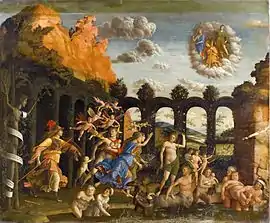Triumph of the Virtues (Mantegna)
The Triumph of the Virtues (also known as Minerva Expelling the Vices from the Garden of Virtue) is a painting by the Italian Renaissance painter Andrea Mantegna, completed in 1502. It is housed in the Musée du Louvre of Paris.
| Triumph of the Virtues | |
|---|---|
 | |
| Artist | Andrea Mantegna |
| Year | 1502 |
| Medium | Tempera on canvas |
| Dimensions | 160 cm × 192 cm (63 in × 76 in) |
| Location | Musée du Louvre, Paris |
The triumph was the second picture painted by Mantegna for Isabella d'Este's studiolo (cabinet), after the Parnassus of 1497. It portrays a marsh enclosed by a tall fence, ruled over by the Vices, portrayed as hideous figures and identified by scrolls in a typically medieval way. Idleness is chased by Minerva, who is also rescuing Diana, goddess of chastity, from being raped by a Centaur, symbol of concupiscence. Next to Minerva is a tree with human features. High in the sky are the three primary moral virtues required to perfect the appetitive powers: Justice, Temperance and Fortitude.
References
- Page at artonline.it Archived 2007-09-28 at the Wayback Machine (in Italian)